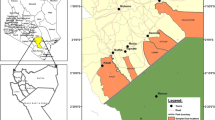Abstract
Tree holdings at homesteads and in homefields were investigated for two villages in Zimbabwe. Of the households, 90% owned at least one exotic tree. Trees were concentrated at homesteads and conserved indigenous trees tended to be edible fruit trees. Female heads of households (divorcees and widows) had fewer trees than households headed by men. Households with longer period of residence at a site had increased the proportion of indigenous fruit trees compared to non-fruit trees. Wealth status showed no relationship to tree holdings. The considerable tree planting and tree conservation activity around homesteads and in homefields has the effect of replacing non-fruit indigenous trees with exotic and indigenous fruit trees. Agroforestry research, extension and development should focus more on current practices, concentrate more on trees that farmers favour (such as fruit trees) and take into account differences among households.
Similar content being viewed by others
References
Bradley PN and Dewees PA (1990) The role of trees and woodlands in Zimbabwe's communal areas. Background paper prepared for World Bank Agricultural Sector Memorandum. Stockholm, Stockholm Environment Institute
Campbell BM, Clarke JM and Gumbo DJ (1991) Traditional agroforestry practices in Zimbabwe. Agrofor Syst 14: 99–111
Carter S, Chidiamassamba A, Jeranyama P, Mafukidze B, Malekela GP, Mvena Z. Mudhara M, Nabane N, van Oosterhout SAM, Price L, Sithole N and Dhlamini R (1993) Some observations on wealth ranking after an RRA looking at soil fertility management in Northeastern Zimbabwe. RRA notes 18, International Institute for Environment and Development, London
Cousins B, Weiner D and Amin N (1992) Social differentiation in the communal lands of Zimbabwe. Rev of African Polit Econ 53, 193–205
Du Toit RF, Campbell BM, Haney RA and Dore D (1984) Wood usage and tree planting in Zimbabwe's communal areas: a baseline survey of knowledge, attitude and practices. Harare, Forestry Commission and the World Bank
Fortmann L and Nabane N (1992a) Poverty and tree resources in Mhondoro District: a Research Note. CASS Occasional Paper Series — NRM, 8/92, Centre for Applied Social Sciences, University of Zimbabwe, Harare
Fortmann L and Nabane N (1992b) The fruits of their labour: gender, property and trees in Mhondoro district. CASS Occasional Paper Series — NRM, 6/92, Centre for Applied Social Sciences, University of Zimbabwe, Harare
Govaerts M (187) Agricultural production and farmer cooperation in Mutoko communal land, Zimbabwe: socio-economic data 1985. COOPIBO, Leuven
Grundy IM, Campbell BM, Balebero S, Tafangenyasha C, Fergusson R and Parry D (1993) Availability and use of trees in Mutanda Resettlement Area, Zimbabwe. For Ecol and Management 56: 243–266
McGregor JM (1991) Woodland resources: ecology, policy and ideology, an historical case study of woodland use in Shurugwi Communal Area, Zimbabwe. PhD thesis, Loughborough University of Technology, Loughborough, Loughborough, UK
Musvoto C and Campbell B (1995) Mango trees as components of agroforestry systems in Mangwende, Zimbabwe. Agrofor Syst 33: 247–260
Price L (1994). The effect of socio-economic factors of household tree holdings and seedling procurement practices in Samatanda and Chigaba village, Mutoko, Zimbabwe, Msc thesis, Biological Sciences Department, University of Zimbabwe
Scoones IC (1995) Investigating difference: applications of wealth ranking and household survey approaches among framing households in Southern Zimbabwe. Develop and Change 26: 75–86
Snedecor GW and Cochran WG (1980) Statistical Methods. Iowa State University Press, Ames, Iowa
Author information
Authors and Affiliations
Rights and permissions
About this article
Cite this article
Price, L., Campbell, B. Household tree holdings: A case study in Mutoko communal area, Zimbabwe. Agroforestry Systems 39, 205–210 (1997). https://doi.org/10.1023/A:1005919717145
Issue Date:
DOI: https://doi.org/10.1023/A:1005919717145




